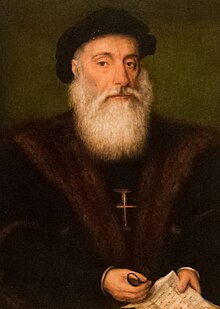Vasco da Gama
| Vasco da Gama | |||||
|---|---|---|---|---|---|
| Admiral of the Seas of Arabia, Persia, India and all the Orients (more...) | |||||
 |
|||||
| Count of Vidigueira | |||||
| Tenure | 29 December 1519 – 24 December 1524 |
||||
| Successor | Francisco da Gama | ||||
| Born | 1460 or 1469 Sines, Alentejo, Kingdom of Portugal |
||||
| Died | 24 December 1524 (aged c. 55–65) Kochi, Portuguese India |
||||
| Burial | Jerónimos Monastery, Lisbon, Kingdom of Portugal | ||||
| Spouse | Catarina de Ataíde | ||||
| Issue Among others |
Francisco da Gama, 2nd Count of Vidigueira Estêvão da Gama, Viceroy of India Cristóvão da Gama, Captain of Malacca |
||||
|
|||||
| Father | Estêvão da Gama | ||||
| Mother | Isabel Sodré | ||||
| Occupation | Explorer, Viceroy of India | ||||
| Signature |  |
||||
| Full name | |
|---|---|
| Vasco da Gama |
Vasco da Gama, 1st Count of Vidigueira (Portuguese pronunciation: [ˈvaʃku ðɐ ˈɣɐmɐ]; c. 1460s – 24 December 1524), was a Portuguese explorer and the first European to reach India by sea. His initial voyage to India (1497–1499) was the first to link Europe and Asia by an ocean route, connecting the Atlantic and the Indian oceans and, in this way, the West and the Orient.
Da Gama's discovery of the sea route to India was significant and opened the way for an age of global imperialism and for the Portuguese to establish a long-lasting colonial empire in Asia. Traveling the ocean route allowed the Portuguese to avoid sailing across the highly disputed Mediterranean and traversing the dangerous Arabian Peninsula. The sum of the distances covered in the outward and return voyages made this expedition the longest ocean voyage ever made until then, far longer than a full voyage around the world by way of the Equator.
After decades of sailors trying to reach the Indies, with thousands of lives and dozens of vessels lost in shipwrecks and attacks, da Gama landed in Calicut on 20 May 1498. Unopposed access to the Indian spice routes boosted the economy of the Portuguese Empire, which was previously based along northern and coastal West Africa. The spices obtained from Southeast Asia were primarily pepper and cinnamon at first, but soon included other products, all new to Europe. Portugal maintained a commercial monopoly of these commodities for several decades. It would be a century later before other European powers such as the Netherlands and England, followed by France and Denmark, were able to challenge Portugal's monopoly and naval supremacy in the Cape Route.
...
Wikipedia
